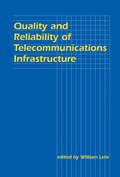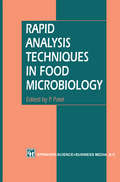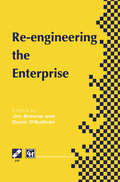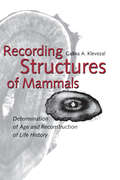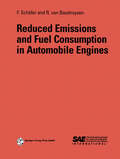- Table View
- List View
Quality and Reliability of Telecommunications Infrastructure: Quality And Reliability Of Telecommunications Infrastructure (LEA Telecommunications Series)
by William LehrIn the last decade, the technology, regulation, and industry structure of our information infrastructure (telephone services, cable and broadcast television, and myriad new data and information services) have changed dramatically. Since the break-up of AT&T's Bell System monopoly, telephone services in the United States are no longer purchased from a single firm. Advances in fiber optics, wireless communications and software-controlled switching are changing how communication services are provided. As the global economy grows more dependent on a hybrid mix of interconnected networks, public officials in the US and abroad are relinquishing control of the market. All of these changes are affecting the quality and reliability of the telecommunications infrastructure, but informed discussions of the public policy and economic issues are scarce. Deregulation and increased competition have lowered prices, but have service quality and reliability suffered? Do advanced network technologies which make it possible to offer a dizzying array of new services increase vulnerability to system-wide failures? Who should or is likely to bear the costs of increased -- or decreased -- service quality? This volume tackles the economic and public policy issues raised by these difficult questions for an audience of industry executives, scholars, and policymakers. Leading scholars and analysts examine such issues as the effects of network ownership on incentives to invest in quality improvements and/or strategies for quality-differentiated pricing in tomorrow's broadband, integrated networks. They analyze the quality of current telecommunications networks and the impact of re-regulation on cable television quality. The contributions range from new microeconomic theory to new empirical research. As such, the volume makes a valuable contribution to the public debate on network quality and reliability. It will be useful both as an introduction to newcomers and as a resource for more experienced researchers. As regulatory, industry and national barriers to integrated communications fall, these issues are likely to become even more important. The research presented here provides a solid foundation for further discussion.
Quantenfeldtheorie: Photonen und ihre Deutung (vieweg studium; Aufbaukurs Physik #75)
by Wilfried Kuhn Janez StrnadEine wichtige Fortführung der Quantentheorie und Grundlage für Elementarteilchenphysik und Lasertheorie ist die Quantenfeldtheorie, die von Richard Feynman und anderen Physikern in der Mitte unseres Jahrhunderts entwickelt wurde. Das Gebiet ist heute Standardstoff im Hauptstudium eines jeden Physik-Studenten. Dieses Buch bietet eine leicht lesbare Einführung in dieses interessante, aber begrifflich nicht leichte Gebiet der modernen Physik. Dabei spielt der harmonische Oszillator die Rolle eines methodischen "Leitfossils". Großer Wert wird dabei auf die Erklärung von Experimenten gelegt, da die Theorie üblicherweise als akademisch angesehen wird und die Effekte zahlenmäßig klein sind.
Quantum Communications and Measurement
by V. P. Belavkin Osamu Hirota R. L. HudsonThe International Workshop on Quantum Communications and Measurement was held at the University of Nottingham from July 10-16, 1994. It followed the successful meeting on Quantum Aspects of Optical Communications in Paris in November 1990. This time the conference was devoted to mathematical, physical and engineering aspects of quantum noise, signal processing and quantum informa tion in open systems, quantum channels, and optical communications. It brought research workers in the experimental and engineering aspects of quantum optics and communication systems into contact with theoreticians working in quantum probability and measurement theory. The workshop was attended by more than 130 participants from 22 different countries. The largest groups [after the UK (31)] were from Japan (19) and from Russia (14). The subjects discussed included the mathematical foundations of quantum communication systems, experiments and devices, the problem of collapse and continuous measurement, quantum input and output processes, causality and nondemolition observation, squeezed states, quan tum jumps, state diffusion and spontaneous localization, filtering and control in quantum systems, and new quantum optical phenomena and effects, including non classical light. These new mathematical and physical ideas were stimulated by recent advances in generation and detection of light with low quantum noise and the development of techniques for trapping a single atom over an extended period of time, making it possible to observe individual quantum phenomena at the macroscopic level.
Quantum Dynamics of Submicron Structures (NATO Science Series E: #291)
by Hilda A. Cerdeira B. Kramer Gerd SchönTechniques for the preparation of condensed matter systems have advanced considerably in the last decade, principally due to the developments in microfabrication technologies. The widespread availability of millikelvin temperature facilities also led to the discovery of a large number of new quantum phenomena. Simultaneously, the quantum theory of small condensed matter systems has matured, allowing quantitative predictions. The effects discussed in Quantum Dynamics of Submicron Structures include typical quantum interference phenomena, such as the Aharonov-Bohm-like oscillations of the magnetoresistance of thin metallic cylinders and rings, transport through chaotic billiards, and such quantization effects as the integer and fractional quantum Hall effect and the quantization of the conductance of point contacts in integer multiples of the `conductance quantum'. Transport properties and tunnelling processes in various types of normal metal and superconductor tunnelling systems are treated. The statistical properties of the quantum states of electrons in spatially inhomogeneous systems, such as a random, inhomogeneous magnetic field, are investigated. Interacting systems, like the Luttinger liquid or electrons in a quantum dot, are also considered. Reviews are given of quantum blockade mechanisms for electrons that tunnel through small junctions, like the Coulomb blockade and spin blockade, the influence of dissipative coupling of charge carriers to an environment, and Andreev scattering. Coulomb interactions and quantization effects in transport through quantum dots and in double-well potentials, as well as quantum effects in the motion of vortices, as in the Aharonov-Casher effect, are discussed. The status of the theory of the metal-insulator and superconductor-insulator phase transitions in ordered and disordered granular systems are reviewed as examples in which such quantum effects are of great importance.
Quantum Electron Liquids and High-Tc Superconductivity (Lecture Notes in Physics Monographs #38)
by Jose Gonzalez Miguel A. Martin-Delgado German Sierra Angeles H. VozmedianoThis book originated from a course given at the Univcrsidad Aut6noma of Madrid in the Spring of 1994 and in the Universidad Complutense of Madrid in 1995. The goal of these courses is to give the non-specialist an introduction to some old and new ideas in the field of strongly correlated systems, in particular the problems posed by the high-1~ superconducting materials. As theoretical physicists, our starting viewpoint to address the problem of strongly correlat ed ferlnion systems and related issues of modern condensed matter physics ·is the renormalization group approach applied both to quantU111 field theory and statistical physics. In recent years this has become not only a powerful tool for retrieving the essential physics of interacting systems but also a link between theoretical physics and modern condensed matter physics. Furthermore, once we have this common background for dealing with apparently different prob lems, we discuss more specific topics and even phenomenological aspects of the field. In doing so we have tried to make the exposition clear and simple, with out entering into technical details but focusing ill the fundamental physics of the phenomena under study. Therefore ,ve expect that our experience ll1ay have some value to other people entering this fascinating field. We have divided these notes into three parts and each part into chapters, which correspond roughly to one or two lectures. Part I, Chaps. 1-2 (A. H. V.
The Quantum Hall Effects: Integral and Fractional (Springer Series in Solid-State Sciences #85)
by Tapash Chakraborty Pekka PietiläinenThe experimental discovery of the fractional quantum Hall effect (FQHE) at the end of 1981 by Tsui, Stormer and Gossard was absolutely unexpected since, at this time, no theoretical work existed that could predict new struc tures in the magnetotransport coefficients under conditions representing the extreme quantum limit. It is more than thirty years since investigations of bulk semiconductors in very strong magnetic fields were begun. Under these conditions, only the lowest Landau level is occupied and the theory predicted a monotonic variation of the resistivity with increasing magnetic field, depending sensitively on the scattering mechanism. However, the ex perimental data could not be analyzed accurately since magnetic freeze-out effects and the transitions from a degenerate to a nondegenerate system complicated the interpretation of the data. For a two-dimensional electron the positive background charge is well separated from the two gas, where dimensional system, magnetic freeze-out effects are barely visible and an analysis of the data in the extreme quantum limit seems to be easier. First measurements in this magnetic field region on silicon field-effect transistors were not successful because the disorder in these devices was so large that all electrons in the lowest Landau level were localized. Consequently, models of a spin glass and finally of a Wigner solid were developed and much effort was put into developing the technology for improving the quality of semi conductor materials and devices, especially in the field of two-dimensional electron systems.
Quantum Transport in Ultrasmall Devices: Proceedings of a NATO Advanced Study Institute on Quantum Transport in Ultrasmall Devices, held July 17–30, 1994, in II Ciocco, Italy (Nato Science Series B: #342)
by David Ferry Harold L. Grubin Carlo Jacoboni A. P. JauhoThe operation of semiconductor devices depends upon the use of electrical potential barriers (such as gate depletion) in controlling the carrier densities (electrons and holes) and their transport. Although a successful device design is quite complicated and involves many aspects, the device engineering is mostly to devise a "best" device design by defIning optimal device structures and manipulating impurity profIles to obtain optimal control of the carrier flow through the device. This becomes increasingly diffIcult as the device scale becomes smaller and smaller. Since the introduction of integrated circuits, the number of individual transistors on a single chip has doubled approximately every three years. As the number of devices has grown, the critical dimension of the smallest feature, such as a gate length (which is related to the transport length defIning the channel), has consequently declined. The reduction of this design rule proceeds approximately by a factor of 1. 4 each generation, which means we will be using 0. 1-0. 15 ). lm rules for the 4 Gb chips a decade from now. If we continue this extrapolation, current technology will require 30 nm design rules, and a cell 3 2 size < 10 nm , for a 1Tb memory chip by the year 2020. New problems keep hindering the high-performance requirement. Well-known, but older, problems include hot carrier effects, short-channel effects, etc. A potential problem, which illustrates the need for quantum transport, is caused by impurity fluctuations.
Quantum Tunneling of Magnetization — QTM ’94 (NATO Science Series E: #301)
by Leon Gunther B. BarbaraThe first NATO Advanced Workshop on Quantum Tunneling of Magnetization (QTM) was organized and co-directed by Bernard Barbara, Leon Gunther, Nicolas Garcia, and Anthony Leggett and was held from June, 27 through July 1, 1994 in Grenoble and Chichilianne, France. These Proceedings include twenty-nine articles that represent the contributions of the participants in the Workshop. Quantum Tunneling of Magnetization is not only interesting for purely academic reasons. It was pointed out in the review article by L. Gunther in the December, 1990 issue of Physics World, that QTM may be destined to play a significant role within the next two decades in limiting the density of information storage in magnetic systems. Recent advances have indicated that this limitation may well be reached even earlier than first predicted. Furthermore, the number of people who have entered the field of study of QTM during these past few years has increased many fi)ld. The time was therefore opportune to hold a Workshop to bring together for the first time the leading researchers of QTM, both theoretical and experimental, so as to discuss the current status of the field. The most controversial issue at the time of the Workshop was how to establish r.eliable criteria for determining whether experimental results do indeed reveal manifestations of QTM. We believe that much progress was made at the Workshop on this issue.
Rapid Analysis Techniques in Food Microbiology
by P. D. PatelThe food industry, with its diverse range of products (e.g. short shelf-life foods, modified atmosphere packaged products and minimally processed products) is governed by strict food legislation, and microbiological safety has become a key issue. Legally required to demonstrate 'due diligence', food manufacturers are demanding analytical techniques that are simple to use, cost effective, robust, reliable and can provide results in 'real time'. The majority of current microbiological techniques (classical or rapid), particularly for the analysis of foodborne pathogens, give results that are only of retrospective value and do not allow proactive or reactive measures to be imple mented during modem food production. Rapid methods for microbial analysis need to be considered in the context of modem Quality Assurance (QA) systems. This book addresses microbiologists, biochemists and immunologists in the food industry, the public health sector, academic and research institutes, and manufacturers of kits and instruments. This volume is an up-to-date account of recent developments in rapid food microbiological analysis, current approaches and problems, rapid methods in relation to QA systems, and future perspectives in an intensely active field. P.D.P. Contributors Public Health Laboratory, Royal Preston Hospital, PO Box F.J. Bolton 202, Sharoe Green Lane North, Preston PR2 4HG, UK. D. M. Gibson Ministry of Agriculture, Fisheries and Food, Torry Research Station, 135 Abbey Road, Aberdeen AB9 8DG, Scotland. P.A. Hall Microbiology and Food Safety, Kraft General Foods, 801 Waukegan Road, Glenview, Illinois 60025, USA.
Rationalisierung und Qualifikationsentwicklung: Eine empirische Analyse im deutschen Maschinenbau (Neue Informationstechnologien und Flexible Arbeitssysteme #7)
by Peter HauptmannsRe-engineering the Enterprise: Proceedings of the IFIP TC5/WG5.7 Working Conference on Re-engineering the Enterprise, Galway, Ireland, 1995 (IFIP Advances in Information and Communication Technology)
by DavidO’Sullivan JimBrowneBusiness process re-engineering tools offer techniques to model the enterprise and identify opportunities to make change. This book examines the approaches, tools and techniques which support redesign of the enterprise to achieve world class performance.
Recording Structures of Mammals
by Galina A. KlevezalThis text focuses on the principles and methods of using growth layers formed in teeth and bones of mammals to make a judgement on essential traits of the animal's life history. In nearly all mammalian species, including man, the age of individuals can be determined from the number of growth layers and, at least in some of them, it is possible to estimate the season of an animal's birth and death, age of sexual maturation, periodicity of reproduction, certain feeding habits and other aspects of the individual's biology. It is also possible, from tooth-enamel analysis, to assess doses of radiation accumulated by animals and human beings during their lifetime.;This book is intended for zoologists, wild-game biologists and zoo archaeologists, but some of the sections could also be of interest for anthropologists, radioecologists and conservation biologists.
Recording Structures of Mammals
by Galina A. KlevezalThis text focuses on the principles and methods of using growth layers formed in teeth and bones of mammals to make a judgement on essential traits of the animal's life history. In nearly all mammalian species, including man, the age of individuals can be determined from the number of growth layers and, at least in some of them, it is possible to estimate the season of an animal's birth and death, age of sexual maturation, periodicity of reproduction, certain feeding habits and other aspects of the individual's biology. It is also possible, from tooth-enamel analysis, to assess doses of radiation accumulated by animals and human beings during their lifetime.;This book is intended for zoologists, wild-game biologists and zoo archaeologists, but some of the sections could also be of interest for anthropologists, radioecologists and conservation biologists.
Reduced Emissions and Fuel Consumption in Automobile Engines
by Fred Schäfer Richard van BasshuysenOver the last several years, there has been much discussion on the interrelation of CO2 emissions with the global warming phenomenon. This in turn has increased pressure to develop and produce more fuel efficient engines and vehicles. This is the central topic of this book. It covers the underlying processes which cause pollutant emissions and the possibilities of reducing them, as well as the fuel consumption of gasoline and diesel engines, including direct injection diesel engines. As well as the engine-related causes of pollution, which is found in the raw exhaust, there is also a description of systems and methods for exhaust post treatment. The significant influence of fuels and lubricants (both conventional and alternative fuels) on emission behavior is also covered. In addition to the conventional gasoline and diesel engines, lean-burn and direct injection gasoline engines and two-stroke gasoline and diesel engines are included. The potential for reducing fuel consumption and pollution is described as well as the related reduction of CO2 emissions. Finally, a detailed summary of the most important laws and regulations pertaining to pollutant emissions and consumption limits is presented. This book is intended for practising engineers involved in research and applied sciences as well as for interested engineering students.
Refractory Linings: ThermoMechanical Design and Applications
by Charles SchachtThis work describes the technology necessary to optimize the performance of any refractory lining. It provides an overview of the thermomechanical behaviour and wear of refractory lining systems, and details the structural behaviour of several classical refractory geometries, highlighting the critical regions of each lining system where high stress is most likely to create fractures.
Refractory Linings: ThermoMechanical Design and Applications
by Charles A. SchachtThis work describes the technology necessary to optimize the performance of any refractory lining. It provides an overview of the thermomechanical behaviour and wear of refractory lining systems, and details the structural behaviour of several classical refractory geometries, highlighting the critical regions of each lining system where high stress is most likely to create fractures.
Regelungstechnik: Eine Einführung (Springer-Lehrbuch)
by Michael CremerDas Buch liefert eine leicht verständliche Einführung in die Regelungstechnik als die methodische Lehre vom Verhalten und der Führung dynamischer Prozesse. Es wendet sich in erster Linie an Wirtschaftingenieure, aber auch an Studenten naturwissenschaftlicher Fächer, die einen fundierten Einstieg in die Grundprinzipien der Systemdynamik und Regelungstechnik suchen.
Regelungstechnik: Grundlagen, Analyse und Entwurf von Regelkreisen, rechnergestützte Methoden (Springer-Lehrbuch)
by Gerd SchulzDieses Lehrbuch über lineare und nichtlineare Regelungen wendet sich vor allem an Studenten der Automatisierungstechnik und verwandter Studiengänge in der praxisorientierten Ausbildung. Der Entwurf von Reglern, insbesondere mit Computerprogrammen wie MATLAB und ACSL, ist sein zentrales Lernziel. Dabei werden Verfahren für Kriterien im Zeitbereich, im Frequenzbereich und mit der Wurzelortkurve einheitlich dargestellt. Um die Ansprüche an die mathematischen Vorkenntnisse des Lernenden niedrig zu halten, wird erst nach ausführlicher Anwendung von Differentialgleichungen zur Laplacetransformation übergegangen. Der Lehrstoff ist verständlich und praxisnah dargestellt und wird beispielhaft erläutert. Zahlreiche Aufgaben und Lösungen sowie durchgerechnete Beispiele ermöglichen die Einübung des Erlernten.
Regenerating Agriculture: An Alternative Strategy for Growth
by Jules N. PrettyFor the past 50 years, the main goal of agriculture has been to increase production at any price, using high amounts of fertilizers and pesticides and intensive industrial methods. This has caused damage to the environment and widespread rural depopulation. This study shows that there is a viable alternative - a form of agriculture which conserves resources, maintains rural employment and minimizes the external costs, without loss of productivity. Using case studies from industrialized and developing countries, the author describes the new technical, institutional and policy options available.
Regenerating Agriculture: An Alternative Strategy for Growth
by Jules N. PrettyFor the past 50 years, the main goal of agriculture has been to increase production at any price, using high amounts of fertilizers and pesticides and intensive industrial methods. This has caused damage to the environment and widespread rural depopulation. This study shows that there is a viable alternative - a form of agriculture which conserves resources, maintains rural employment and minimizes the external costs, without loss of productivity. Using case studies from industrialized and developing countries, the author describes the new technical, institutional and policy options available.
Reliability and Optimization of Structural Systems: Proceedings of the sixth IFIP WG7.5 working conference on reliability and optimization of structural systems 1994 (IFIP Advances in Information and Communication Technology)
by Rudiger Rackwitz Guiliano Augusti Antonio BorriThe 6th meeting sponsored by IFIP Working Group 7.5, on reliability and optimization of structural systems, took place in September 1994 in Assisi, Italy. This book contains the papers presented at the working conference including topics such as reliability of special structures, fatigue, failure modes and time-variant systems relibility.
Reliability and Safety Analyses under Fuzziness (Studies in Fuzziness and Soft Computing #4)
by Takehisa OnisawaThis book provides a comprehensive, up-to-date account on recent applications of fuzzy sets and possibility theory in reliability and safety analysis. Various aspects of system's reliability, quality control, reliability and safety of man-machine systems fault analysis, risk assessment and analysis, structural, seismic, safety, etc. are discussed. The book provides new tools for handling non-probabilistic aspects of uncertainty in these problems. It is the first in this field in the world literature.
Relic (Agent Pendergast #1)
by Douglas Preston Lincoln ChildThe New York Museum of Natural History is built over a subterranean labyrinth of neglected specimen vaults, unmapped drainage tunnels and long-forgotten catacombs. And there's something down there. When the mutilated bodies of two young boys are discovered deep within the museum's bowels, Lieutenant Vincent D'Agosta of the NYPD fears a homicidal maniac may be at large. FBI agent Aloysius X.L. Pendergast believes they may be facing something much worse. As the death toll mounts, and with the opening of the museum's new 'Superstition' exhibition just days away, the two men must work together to prevent a massacre. 'Sit back, crack open the book and get ready for the ride of your life' DAVID BALDACCI. 'White-hot bestselling suspense. Simply brilliant!' LISA GARDNER.
